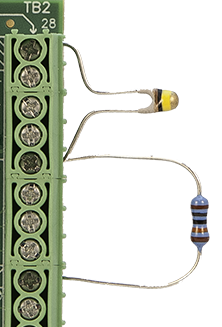IoT devices work best when they're able to respond without human intervention, so lets build a temperature sensor with an alarm.
This exercise will use a protoboard setup from the Sounding an Audible Alarm exercise. If you need to, take a moment to check it out and make sure your protoboard is assembled correctly. Don't worry, we'll wait.
 You'll first need to connect a resistor (blue) to the SN171 protoboard. Bend the legs of the resistor toward one another as seen in the picture. Place one resistor leg into the terminal block labeled GPIO 18 (located on the upper right-hand side of the SN171 protoboard.)
You'll first need to connect a resistor (blue) to the SN171 protoboard. Bend the legs of the resistor toward one another as seen in the picture. Place one resistor leg into the terminal block labeled GPIO 18 (located on the upper right-hand side of the SN171 protoboard.)Hold the thermistor between your thumb and forefinger to raise the temperature. (If you have especially cold hands, it may be necessary to warm your hands first, or to rub the thermistor to warm it up. You may also blow over the thermistor to warm it up.) Once it reaches a pre-set threshold it will trigger a 5 second timer. The start of the timer will be indicated by the green LED on the SN171 protoboard and the flashing amber LED on the SN132 SNAPstick.
The buzzer will sound once the timer expires unless the alarm cut-off is executed. This can done one of two ways:
A quick “chirp” of the buzzer will indicate that the alarm is bypassed. (Much like the “chirp” of a car alarm.)
The strength of the Internet of Things is that it provides a means for monitoring things in ways that would not be possible for a human. A SNAP node can tirelessly monitor a sensor for a condition, and when that condition is met, it can respond in multiple ways. In this example, the node sounded an audible alarm, but that might be just one part of the response. It could just as easily sound a buzzer, send an email, and shut off a valve, all in rapid succession.
This is where we can see the strength of a "sense and respond network". It's helpful to get an email telling you something is wrong. It's better to get an email telling you that something WAS wrong, and measures were put into place to limit harm.